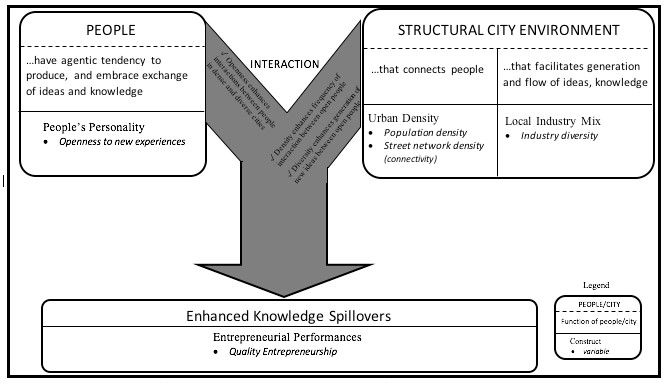Throughout her career as an influential author, theorist, journalist and activist, Jane Jacobs fought on behalf of the city. Where others saw despair, fear and abandonment, she championed her vision of a city in which people flourished in welcoming and connected neighbourhoods, providing homes and work for a fulfilling life in the city. In the battle for Greenwich Village, she famously helped save a desperate neighbourhood in New York City from succumbing to a misdirected major urban renewal project prioritizing concrete and buildings, including a mass-transit expressway, over people and their inherently human needs. Where others saw the opportunity for efficiency and structure, her vision emanated from always putting people first.
Jacobs championed her priority on putting people first, and how a city can empower them. She described a successful city life with vivid metaphors such as “the sidewalk ballet” and “eyes on the street”, where residents thrive from diversity, interactions, learning and an open culture.
Conventional thinking revolved around city planning and economic efficiency, with an emphasis on orderly zoning of neighbourhoods and districts, which led to the inevitable segregation of people and wide-open spaces. By contrast, Jacobs saw the promise of a dense, more “chaotic” but authentic experience for people through their interactions in neighbourhoods. She was convinced that “the task is to promote the city life of city people, housed, let us hope, in concentrations both dense enough and diverse enough to offer them a decent chance at developing city life” (Jacobs, 1961, p. 221). In her influential book, The Death and Life of Great American Cities, she attributed the failure of urban planning to a paucity of empowerment of people in cities.
While Jane Jacobs and her people-focused theorizing left a major mark in urban studies, sociology, and urban planning and economics, empirical research addressing the economic performance of cities and their people often focused solely on the physical and industrial structures of cities – which addressed Jacob’s original people focus only very indirectly, if at all. For all the progress in research and analysis to understand what drives urban success and vitality, the core message and spirt of Jacobs had been overlooked.
In an innovative major study, Sam Tavassoli from RMIT’s School of Management together with Martin Obschonka from QUT and David Audretsch from Indiana University, rediscover the forgotten insights and wisdom of Jane Jacobs, by examining her thesis that the human dimension of people matter in shaping urban vitality. In particular, their study draws on data from 362 American cities with a focus on the entrepreneurial spirit, and thus economic growth in a city – as a sign of a vibrant city life.
Specifically, the study examined how the favourable structural city environment envisioned by Jacobs (urban density and diversity) empowers people in cities to ignite a stronger entrepreneurial spirit and fuel economic growth. Urban density and diversity characterize how neighbourhoods, houses and streets are built, enabling people to come together and learn from each other, along with the ensuring diversity emanating from flourishing neighbourhoods. A novel approach of the study was to create a psychological profile for each city, with a special focus on psychological openness – a particularly important psychological orientation of people in the context of learning, innovation and interactions. The study draws on psychological data collected from millions of people, enabling the authors to develop a model of how psychological openness in a city interacts with a favourable city environment (Figure 1).
Figure 1: Entrepreneurship in cities: Agentic populations, structural city environment, and their interaction

Supporting and extending Jacobs’ thinking, the study revealed that cities that exhibit a particular empowering effect are not only those with a physical infrastructure that is more Jacobian (density and diversity) but also where more people have an open orientation – where psychological openness is particularly strong.
The most compelling finding suggests that combining a strong open orientation of its people with a Jacobian infrastructure results in high impact entrepreneurship (e.g., startups with the potential to grow significantly). As Jacobs envisioned, one secret of great entrepreneurial cities seems to be that open-minded people are empowered by a city environment, bringing many open-minded people together in dense, relatively “chaotic” places so that they can interact with each other, share new ideas and knowledge, and ultimately inspire their creativity and energy. Empowering people liberates their imaginations and creative energy, fuelling their engagement and entrepreneurial impulses. Not only is the human spirit lifted though interactions among people in a city, but the flow of new ideas inspiring vital new innovations flourishes.
The study should change thinking in both research and practice. In the context of research, it underscores that the sorely neglected people focus by Jane Jacobs lies at the core of urban vitality and economic growth. For practitioners, the study underscore Jacobs’ mantra to urban planners and policy makers: the city’s people and their empowerment by smart city planning is vital. At the same, the openness of people in a city also matters by serving as a crucial ingredient fuelling knowledge spillovers and impactful enterprising activities that ultimately make great entrepreneurial cities. After all this time and years of neglect, Jane Jacobs has proven to be right -- power to the people, especially in those cities with open-minded and highly interactive people.
Author: Dr Sam Tavassoli, School of Management
Source: Tavassoli, S., Obschonka, M., Audretsch, D. A. (2021). Entrepreneurship in cities, Research Policy, 50(7), 1-21. https://doi.org/10.1016/j.respol.2021.104255








